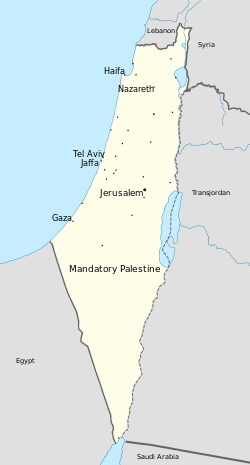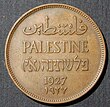ปาเลสไตน์ในอาณัติ
หน้าตา
(เปลี่ยนทางจาก รัฐอารักขาปาเลสไตน์)
ปาเลสไตน์ในอาณัติ | |||||||||||||
|---|---|---|---|---|---|---|---|---|---|---|---|---|---|
| 1920–1948 | |||||||||||||
 ปาเลสไตน์ในอาณัติใน ค.ศ. 1946 | |||||||||||||
| สถานะ | อาณาเขตในอาณัติของสหราชอาณาจักร | ||||||||||||
| เมืองหลวง | เยรูซาเลม | ||||||||||||
| ภาษาทั่วไป | อังกฤษ, อาหรับ, ฮีบรู | ||||||||||||
| ศาสนา | อิสลาม, ยูดาห์, คริสต์, บาไฮ, ดรูซ | ||||||||||||
| ข้าหลวงใหญ่ | |||||||||||||
• 1920–1925 (คนแรก) | เซอร์ เฮอร์เบิร์ต แอล. ซามูเอล | ||||||||||||
• 1945–1948 (สุดท้าย) | เซอร์ อลัน คันนิงแฮม | ||||||||||||
| สภานิติบัญญัติ | |||||||||||||
• สภาสังคมมุสลิม | สภามุสลิมสูงสุด | ||||||||||||
• สภาสังคมยิว | สภาผู้แทนราษฎร | ||||||||||||
| ยุคประวัติศาสตร์ | สมัยระหว่างสงคราม, สงครามโลกครั้งที่สอง, สงครามเย็น | ||||||||||||
• ลงนามสัญญา | 25 เมษายน 1920 | ||||||||||||
• อังกฤษถือครองอย่างเป็นทางการ | 29 กันยายน ค.ศ. 1923 | ||||||||||||
• ประกาศ | 14 พฤษภาคม 1948 | ||||||||||||
| สกุลเงิน | ปอนด์อียิปต์ (จนถึง ค.ศ. 1927) ปอนด์ปาเลสไตน์ (ตั้งแต่ ค.ศ. 1927) | ||||||||||||
| |||||||||||||
| ปัจจุบันเป็นส่วนหนึ่งของ | ประเทศอิสราเอล รัฐปาเลสไตน์ | ||||||||||||
ปาเลสไตน์ในอาณัติ (อังกฤษ: Mandatory Palestine;[1] อาหรับ: فلسطين; ฮีบรู: פָּלֶשְׂתִּינָה (א"י) Pālēśtīnā (E.Y.), ซึ่ง "E.Y." ย่อจาก Ērētz Yīśrā'ēl, ดินแดนของอิสราเอล) เป็นหน่วยภูมิรัฐศาสตร์ ภายใต้การดูแลของสหราชอาณาจักร ในส่วนที่เป็นเขตจักรวรรดิออตโตมันและซีเรียตอนใต้ ภายหลังจากสงครามโลกครั้งที่ 1 ระหว่าง พ.ศ. 2463 จนถึง 2491
ชื่อ
[แก้]ตราไปรษณียากร ค.ศ. 1927
เหรียญเงินปาเลสไตน์ ค.ศ. 1927
"ปาเลสไตน์" ในภาษาอังกฤษ (อังกฤษ: Palestine) ภาษาอาหรับ (อาหรับ: فلسطين) และภาษาฮีบรู (ฮีบรู: פָּלֶשְׂתִּינָה (א"י)
) ภาษาสุดท้ายมีอักษรย่อ א״י สำหรับ Eretz Yisrael (ดินแดนอิสราเอล)
ชื่อดินแดนในอาณัตินี้คือ "ปาเลสไตน์" เพื่อสอดคล้องกับการใช้งานของชาวอาหรับปาเลสไตน์และออตโตมัน[2][3][4][5] กฎบัตรอาณัติระบุว่าปาเลสไตน์ในอาณัติมีภาษาราชการสามภาษาคืออังกฤษ, อาหรับ และฮีบรู
ส่วนคำว่า "อาณัติ" สื่อถึงสถานะทางกฎหมายจากดินแดนในอาณัติของสันนิบาตชาติ ซึ่งไม่มีความเกี่ยวข้องกับคำที่ใช้กันทั่วไปที่มีความหมายพ้องกันอย่าง "ภาคบังคับ" หรือ "จำเป็น"[6]
ประวัติศาสตร์
[แก้]ส่วนนี้รอเพิ่มเติมข้อมูล คุณสามารถช่วยเพิ่มข้อมูลส่วนนี้ได้ |
การถ่ายโอนอำนาจบริหารจากทหารสู่พลเรือน
[แก้]ส่วนนี้รอเพิ่มเติมข้อมูล คุณสามารถช่วยเพิ่มข้อมูลส่วนนี้ได้ |
วิกฤติการณ์อาหรับ ค.ศ. 1930
[แก้]ส่วนนี้รอเพิ่มเติมข้อมูล คุณสามารถช่วยเพิ่มข้อมูลส่วนนี้ได้ |
การปฏิวัติอาหรับ
[แก้]
ส่วนนี้รอเพิ่มเติมข้อมูล คุณสามารถช่วยเพิ่มข้อมูลส่วนนี้ได้ |
สงครามโลกครั้งที่ 2
[แก้]การรบระหว่าง พันธมิตร และ อักษะ
[แก้]ส่วนนี้รอเพิ่มเติมข้อมูล คุณสามารถช่วยเพิ่มข้อมูลส่วนนี้ได้ |
ฮอโลคอสต์ และ การจำกัดผู้อพยพ
[แก้]ส่วนนี้รอเพิ่มเติมข้อมูล คุณสามารถช่วยเพิ่มข้อมูลส่วนนี้ได้ |
สิ้นสุดสงครามโลกครั้งที่ 2: การแบ่งดินแดน
[แก้]ส่วนนี้รอเพิ่มเติมข้อมูล คุณสามารถช่วยเพิ่มข้อมูลส่วนนี้ได้ |
การเมืองการปกครอง
[แก้]รัฐบาล
[แก้]ส่วนนี้รอเพิ่มเติมข้อมูล คุณสามารถช่วยเพิ่มข้อมูลส่วนนี้ได้ |
เศรษฐกิจ
[แก้]ส่วนนี้รอเพิ่มเติมข้อมูล คุณสามารถช่วยเพิ่มข้อมูลส่วนนี้ได้ |
การศึกษา
[แก้]ส่วนนี้รอเพิ่มเติมข้อมูล คุณสามารถช่วยเพิ่มข้อมูลส่วนนี้ได้ |
อัตราการรู้หนังสือ
[แก้]ส่วนนี้รอเพิ่มเติมข้อมูล คุณสามารถช่วยเพิ่มข้อมูลส่วนนี้ได้ |
อ้างอิง
[แก้]- ↑ "League of Nations decision confirming the Principal Allied Powers' agreement on the territory of Palestine". คลังข้อมูลเก่าเก็บจากแหล่งเดิมเมื่อ 25 November 2013.
- ↑ Nur Masalha (2018). Palestine: A Four Thousand Year History. Zed. ISBN 978-1-78699-272-7. Chapter 9: Being Palestine, becoming Palestine, p. 287: "the sense of continuity between the ancient, medieval and modern political geography and naming traditions of Palestine eventually came into play in the designation of the British Mandatory Government of Palestine". The preceding pages, p.259-287, document in detail the usage of the term Palestine by native Palestinians from the moment the printing press was introduced into the area in the late 19th century.
- ↑ Khalidi 1997, pp. 151–152.
- ↑ Büssow, Johann (11 August 2011). Hamidian Palestine: Politics and Society in the District of Jerusalem 1872–1908. BRILL. p. 5. ISBN 978-90-04-20569-7. สืบค้นเมื่อ 17 May 2013.
- ↑ |The 1915 Filastin Risalesi ("Palestine Document") is a country survey of the VIII Corps of the Ottoman Army, which identified Palestine as a region including the sanjaqs of Akka (the Galilee), the Sanjaq of Nablus, and the Sanjaq of Jerusalem (Kudus Sherif), see Ottoman Conceptions of Palestine-Part 2: Ethnography and Cartography, Salim Tamari
- ↑ Rayman, Noah (29 September 2014). "Mandatory Palestine: What It Was and Why It Matters". Time. เก็บจากแหล่งเดิมเมื่อ 26 May 2020.
บรรณานุกรม
[แก้]- Pappé, Ilan (15 August 1994). "Introduction". The Making of the Arab–Israeli Conflict, 1947–1951. I.B.Tauris. ISBN 978-1-85043-819-9. สืบค้นเมื่อ 2 May 2009.
- Khalidi, Rashid (2006). The Iron Cage: The Story of the Palestinian Struggle for Statehood. Beacon Press. ISBN 978-0-8070-0308-4. สืบค้นเมื่อ 2 May 2009.
- Khalidi, Rashid (2007) [1st ed. 2001]. "The Palestinians and 1948: the underlying causes of failure". ใน Eugene L. Rogan & Avi Shlaim (บ.ก.). The War for Palestine: Rewriting the History of 1948 (2nd ed.). Cambridge University Press. ISBN 978-0-521-69934-1. สืบค้นเมื่อ 2 May 2009.
- Khalidi, Walid (1987) [Original in 1971]. From Haven to Conquest: Readings in Zionism and the Palestine Problem Until 1948. Institute for Palestine Studies. ISBN 978-0-88728-155-6. สืบค้นเมื่อ 2 May 2009.
- Khalidi, Rashid (1997), Palestinian Identity: The Construction of Modern National Consciousness, Columbia University Press, ISBN 9780231521741
- Morris, Benny (2001) [1999]. Righteous Victims: A History of the Zionist–Arab Conflict, 1881–1999. New York: Alfred A. Knopf. ISBN 978-0-679-74475-7. สืบค้นเมื่อ 2 May 2009.
- Aruri, Naseer Hasan (1972). Jordan: A Study in Political Development 1923–1965. The Hague: Martinus Nijhoff Publishers. ISBN 978-90-247-1217-5. สืบค้นเมื่อ 2 May 2009.
- Biger, Gideon (2004). The Boundaries of Modern Palestine, 1840–1947. London: Routledge. ISBN 978-0-7146-5654-0. สืบค้นเมื่อ 2 May 2009.
- Louis, Wm. Roger (1969). "The United Kingdom and the Beginning of the Mandates System, 1919–1922". International Organization. 23 (1): 73–96. doi:10.1017/s0020818300025534.
- Segev, Tom (2001) [Original in 2000]. "Nebi Musa, 1920". One Palestine, Complete: Jews and Arabs Under the British Mandate. Trans. Haim Watzman. London: Henry Holt and Company. ISBN 978-0-8050-6587-9. สืบค้นเมื่อ 2 May 2009.
- Stein, Kenneth W. (1987) [Original in 1984]. The Land Question in Palestine, 1917–1939. University of North Carolina Press. ISBN 978-0-8078-4178-5. สืบค้นเมื่อ 2 May 2009.
- Gilbert, Martin (1998). Israel: a history. Doubleday. ISBN 978-0-385-40401-3. สืบค้นเมื่อ 2 May 2009.
- Shapira, Anita (1992). Land and Power: The Zionist Resort to Force, 1881–1948. trans. William Templer. Oxford University Press. ISBN 978-0-19-506104-8. สืบค้นเมื่อ 2 May 2009.
- Black, Ian (1991). Israel's Secret Wars: A History of Israel's Intelligence Services. Morris, Benny. Grove Press. ISBN 978-0-8021-1159-3.
- Avneri, Aryeh L. (1984). The Claim of Dispossession: Jewish Land-Settlement and the Arabs, 1878–1948. Transaction Publishers. ISBN 978-0-87855-964-0. สืบค้นเมื่อ 2 May 2009.
- Khalaf, Issa (1991). Politics in Palestine: Arab Factionalism and Social Disintegration, 1939–1948. State University of New York Press. ISBN 978-0-7914-0708-0. สืบค้นเมื่อ 6 May 2009.
- Bayliss, Thomas (1999). How Israel Was Won: A Concise History of the Arab–Israeli Conflict. Lexington Books. ISBN 978-0-7391-0064-6
- Bethell, Nicholas The Palestine Triangle: the Struggle Between the British, the Jews and the Arabs, 1935–48, London: Deutsch, 1979 ISBN 0-233-97069-X.
- El-Eini, Roza I.M. (2006). Mandated Landscape: British Imperial Rule in Palestine, 1929–1948. London: Routledge. ISBN 978-0-7146-5426-3. สืบค้นเมื่อ 5 May 2009.
- Hughes, Matthew, บ.ก. (2004). Allenby in Palestine: The Middle East Correspondence of Field Marshal Viscount Allenby June 1917 – October 1919. Army Records Society. Vol. 22. Phoenix Mill, Thrupp, Stroud, Gloucestershire: Sutton Publishing Ltd. ISBN 978-0-7509-3841-9.
- Katz, Shmuel (1973). Battleground: Fact and Fantasy in Palestine. Bantam Books. ISBN 978-0-929093-13-0. สืบค้นเมื่อ 2 May 2009.
- Paris, Timothy J. (2003). Britain, the Hashemites and Arab Rule, 1920–1925: The Sherifian Solution. London: Routledge. ISBN 0-7146-5451-5
- Sherman, A J (1998).Mandate Days: British Lives in Palestine, 1918–1948, Thames & Hudson. ISBN 0-8018-6620-0
- Vareilles, Guillaume (2010). Les frontières de la Palestine, 1914–1947, Paris, L'Harmattan. ISBN 978-2-296-13621-2
อ่านเพิ่ม
[แก้]- Bar-Yosef, Eitan. "Bonding with the British: Colonial Nostalgia and the Idealization of Mandatory Palestine in Israeli Literature and Culture after 1967." Jewish Social Studies 22.3 (2017): 1–37. online
- Cohen, Michael J. Britain's Moment in Palestine: Retrospect and Perspectives, 1917–1948 (2014)
- El-Eini, Roza. Mandated landscape: British imperial rule in Palestine 1929–1948 (Routledge, 2004).
- Galnoor, Itzhak. Partition of Palestine, The: Decision Crossroads in the Zionist Movement (SUNY Press, 2012).
- Hanna, Paul Lamont, "British Policy in Palestine", Washington, D.C., American Council on Public Affairs, (1942)
- Harris, Kenneth. Attlee (1982) pp 388–400.
- Kamel, Lorenzo. "Whose Land? Land Tenure in Late Nineteenth- and Early Twentieth-Century Palestine", "British Journal of Middle Eastern studies" (April 2014), 41, 2, pp. 230–242.
- Miller, Rory, ed. Britain, Palestine and Empire: The Mandate Years (2010)
- Morgan, Kenneth O.The People's Peace: British history 1945 – 1990 (1992) 49–52.
- Ravndal, Ellen Jenny. "Exit Britain: British Withdrawal From the Palestine Mandate in the Early Cold War, 1947–1948," Diplomacy and Statecraft, (Sept 2010) 21#3 pp. 416–433.
- Roberts, Nicholas E. "Re‐Remembering the Mandate: Historiographical Debates and Revisionist History in the Study of British Palestine." History Compass 9.3 (2011): 215–230. online[ลิงก์เสีย].
- Sargent, Andrew. " The British Labour Party and Palestine 1917–1949" (PhD thesis, University of Nottingham, 1980) online
- Shelef, Nadav G. "From 'Both Banks of the Jordan' to the 'Whole Land of Israel:' Ideological Change in Revisionist Zionism." Israel Studies 9.1 (2004): 125–148. Online
- Sinanoglou, Penny. "British Plans for the Partition of Palestine, 1929–1938." Historical Journal 52.1 (2009): 131–152. online
- Wright, Quincy, The Palestine Problem, Political Science Quarterly, 41#3 (1926), pp. 384–412, online.
แหล่งข้อมูลอื่น
[แก้] วิกิมีเดียคอมมอนส์มีสื่อเกี่ยวกับ British Mandate of Palestine
วิกิมีเดียคอมมอนส์มีสื่อเกี่ยวกับ British Mandate of Palestine






